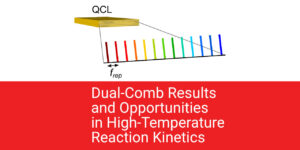Dual-Comb Results and Opportunities in High-Temperature Reaction Kinetics
14 Maggio 2020
 Dual-Comb Results and Opportunities in High-Temperature Reaction Kinetics, with Markus Geiser and Nicolas Pinkowski (Stanford University)
Dual-Comb Results and Opportunities in High-Temperature Reaction Kinetics, with Markus Geiser and Nicolas Pinkowski (Stanford University)
High-temperature reactions kinetics provides an exciting and highly challenging proving ground for the IRis-F1 quantum-cascade-laser-based dual-comb spectrometer (DCS).
In this study, a 1.0 ms high-temperature reaction between propyne and oxygen was studied. The DCS interfaced with a shock tube that was used to shock-heat 2% p-C3H4/18% O2/Ar to temperatures where the mixture would combust (over 1200 K and approximately 3 atm).This application space was assessed together by IRsweep and Professor Ronald Hanson’s shock tube laboratory at Stanford University. This study involved a proof-of-concept experimental campaign that involved the integration of a QCL-DCS with a shock tube facility.
The spectrometer used consisted of two free-running, non-stabilized frequency combs each emitting at 179 wavelengths between 1174 and 1233 cm−1. A free spectral range, ƒr, of 9.86 GHz and a difference in comb spacing, Δƒr, of 5 MHz, enabled a theoretical time resolution of 0.2 µs but the data was time-integrated down to as fast as 4 µs and assessed.
The accuracy of the spectrometer was monitored using a suite of independent laser diagnostics and this presentation discusses both good agreement and other challenges that are now areas of future study. The use of dual-comb spectrometer’s with good time resolution provides an intriguing opportunity for the measurement and interrogation of the high-temperature evolving spectra of harsh and dynamic environments.
Time: May 14, 2020 05:00 PM in Zurich
Click here to register




